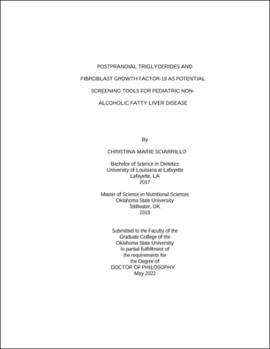| dc.contributor.advisor | Emerson, Sam R. | |
| dc.contributor.author | Sciarrillo, Christina Marie | |
| dc.date.accessioned | 2023-03-31T19:14:58Z | |
| dc.date.available | 2023-03-31T19:14:58Z | |
| dc.date.issued | 2022-05 | |
| dc.identifier.uri | https://hdl.handle.net/11244/337181 | |
| dc.description.abstract | Background: Screening tools for pediatric NAFLD are lacking. We tested the hypothesis that the postprandial triglyceride (TG) and FGF19 response to an abbreviated fat tolerance test (AFTT) could discriminate children with NAFLD from obese and normal weight peers. | |
| dc.description.abstract | Methods: In this cross-sectional study, 15 normal weight controls (NW; 6M/9F; age: 17 ± 2y; BMI: 49 ± 24 %ile), 13 controls with obesity without NAFLD (OB; 5M/8F; age: 17 ± 2y; BMI: 98 ± 1 %ile), and 9 patients with NAFLD (7M/2F; age: 15 ± 2y; BMI: 99 ± 0 %ile) completed an AFTT. Following an overnight fast, participants consumed a high-fat meal (73% fat; 9 kcal/kg) and TG and FGF19 were measured at baseline and 4h post-meal. Liver steatosis (controlled attenuation parameter (CAP)) and fibrosis (stiffness) were measured via Fibroscan. | |
| dc.description.abstract | Results: There were no group differences in fasting TG (p > 0.05). NAFLD and OB exhibited greater 4h TG (197 ± 69 mg/dL; 157 ± 72 mg/dL, respectively) than NW (105 ± 45 mg/dL; p < 0.05), but NAFLD did not differ from OB control (p > 0.05). Within the entire sample, when 4h TG were stratified by high (CAP ≥ 220 dB/m) and low (CAP ≤ 220 dB/m) steatosis, children with high steatosis had 98% greater 4h TG (170 ± 69 mg/dL) compared to children with low steatosis (86 ± 25 mg/dL; p = 0.0004). Fasting and 4h FGF19 did not differ across groups (p > 0.05). Across all groups, fasting FGF19 and 4h postprandial FGF19 were 226% and 258% higher in children with low steatosis compared to high steatosis, respectively (p < 0.05). Using ROC, the only outcome with diagnostic accuracy for NAFLD was 4h TG (0.77 [95% CI: 0.60-0.94; p = 0.02]). | |
| dc.description.abstract | Conclusions: These findings suggest that the postprandial TG response in NAFLD is greater in children with NAFLD compared to NW peers without NAFLD but does not differ between children with NAFLD and children with obesity, which is likely related to steatosis detected in the OB group. Despite no differences across groups, the postprandial rise in FGF19 was blunted in children with high liver steatosis. | |
| dc.format | application/pdf | |
| dc.language | en_US | |
| dc.rights | Copyright is held by the author who has granted the Oklahoma State University Library the non-exclusive right to share this material in its institutional repository. Contact Digital Library Services at lib-dls@okstate.edu or 405-744-9161 for the permission policy on the use, reproduction or distribution of this material. | |
| dc.title | Postprandial triglycerides and fibroblast growth factor-19 as potential screening tools for pediatric non-alcoholic fatty liver disease | |
| dc.contributor.committeeMember | Short, Kevin R. | |
| dc.contributor.committeeMember | Clarke, Stephen L. | |
| dc.contributor.committeeMember | Lucas, Edralin A. | |
| dc.contributor.committeeMember | Hawkins, Misty A. | |
| osu.filename | Sciarrillo_okstate_0664D_17635.pdf | |
| osu.accesstype | Open Access | |
| dc.type.genre | Dissertation | |
| dc.type.material | Text | |
| dc.subject.keywords | metabolism | |
| dc.subject.keywords | non-alcoholic fatty liver disease | |
| dc.subject.keywords | obesity | |
| dc.subject.keywords | postprandial metabolism | |
| dc.subject.keywords | triglycerides | |
| thesis.degree.discipline | Nutritional Science | |
| thesis.degree.grantor | Oklahoma State University | |
